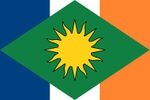1726 Vegno Elections
| |||||||||||||||||||||||||||||||||||||||||||||||||||||||||||||||||||||||||||||||
| |||||||||||||||||||||||||||||||||||||||||||||||||||||||||||||||||||||||||||||||
| Turnout: 3,584,169 (89% of entitled) | |||||||||||||||||||||||||||||||||||||||||||||||||||||||||||||||||||||||||||||||
The 1726 AN Vegno Elections were the sixth ever general elections of the Republic of Vegno and saw the election of the President of the Republic of Vegno and the composition of the Parliament, the Assemblea Nazionale.
The Parliament met for the first session of the fourth legislature on early 1727 AN. Following the constitutional reform approved in 1708 by the Mancuso I Cabinet, each legislature will last five years. As the General Election of Vegno, population voted both for the President of the Republic, with the two most voted candidates accessing the final ballot a week after, and for the composition of the Parliament, which reflected the formation of the new government.
The Presidential elections were won, for the third time, by Antonio Visciglia, who became the first ever politician to be President of the Republic of Vegno for the third time; while the parliamentary elections were won by the Partito Nazionalista Vegnese, which obtain the 32,62% of national vote and 84 seats in the Assemblea Nazionale.
The political framework emerged from these elections led to the famous "Historical Compromise" between the Partito Democratico Costituzionale and the Partito Nazionalista Vegnese, forming the Unno II Cabinet.
Voting system
The electoral law in force is the "Rinaldellum", which regulated elections for the first time,replacing the electoral law of 1708 AN and provides for a mixed electoral system, where:
- 66,66% of the seats (100 of 150 in the Assemblea Nazionale) are assigned through the proportional system in multi-member constituencies on the basis of blocked lists; the allocation of seats is carried out at regional levels.
- 33,33% of the seats (50 of 150 in the Assemblea Nazionale) are assigned with a single-round majority system (1 seat for the most voted party in each single circumscription.
In accordance with the Constitution, modified by the Mancuso I Cabinet 150 deputies are elected. Furthermore, the composition of the parliament and the mandate of President of the Republic will now last for five years instead of three.
The voting paper, which is a single one for the majority and the proportional systems, shows the names of the candidates to single-member constituencies and in close conjunction with them the symbols of the linked lists for the proportional part, each one with a list of the relative candidates. The voter is able to cast their vote in three different ways, among them:
- Drawing a sign on the symbol of a list. In this case, the vote extends to the candidate in the single-member constituency that is supported by that list.
- Drawing a sign on the name of the candidate of the single-member constituency and another one on the symbol of one list that supports them; the result is the same as that described above. Under penalty of annullment, the panachage is not allowed, so the voter cannot vote simultaneously for a candidate in the uninominal constituency and for a list which is not linked to them.
- Drawing a sign only on the name of the candidate for the uninominal constituency, without indicating any list. In this case, the vote is valid for the candidate in the single-member constituency and also automatically extended to the list that supports them; however, if that candidate is connected to several lists, the vote is divided proportionally between them, based on the votes that each one has obtained in that constituency.
Background
- The political context found before the 1726 elections, unlike the previous ones, was a picture of great stability. The previous elections had resulted in a very fragmented parliament which had led to the formation of a technical government, presided over by Antonio Visciglia and Angelo Greco, for the first time in history.
During the Greco I Cabinet, the new electoral law was launched, which still provided for a mixed proportional-majority system, but with an increase in the majority share up to 33%, to guarantee greater stability to parliament and governments. Furthermore, 50 constituencies were established, based on population, whose winning party in each individual constituency would obtain a majority seat in parliament.
Greco's technical government had had, in its 5 years of mandate, great stability, with all the political forces agreeing on the fact that some specific interventions were necessary to improve the country, but without forgetting the need to have a government led by real political and non-independent forces.
For the first time, therefore, the situation preceding the elections is very uncertain, without a political force more favored over the others, with only the figures of Antonio Visciglia, outgoing president, and Angelo Greco, officially not taking part in the electoral campaign, to inspire confidence in the electorate.
Electoral campaign

The electoral campaign for the Venetian elections of 1726 took place in a climate of strong polarization between the various political forces, which tried to gain the consensus of voters with different strategies and proposals.

The Unione Democratica, a centre-left coalition that brings together the Partito Democratico Costituzionale, the Partito Comunista and Vegno Vivo, has focused on the positive balance of the Greco I Cabinet, supported by the outgoing President of the Republic Visciglia, who has led the country in a period of strong political and social crisis, and promised to continue the reforms in favor of social justice, democratic participation and international solidarity, as well as the new electoral law launched to deal with the fragmented nature of the vegnese political framework. The leader of the coalition, Antonio Visciglia, underlined the need to maintain political stability and counteract populist and nationalist forces that threaten the values of the Republic and democracy. Despite Visciglia's numerous attempts to convince Greco, after his fruitful government experience, to join the ranks of the PCD, the latter denied any involvement in the vegnese electoral campaign, but did not exclude the possibility of being involved in subsequent government roles, always as an independent.
The centre-right coalition, formed by the Partito Nazionalista Vegnese and Forza Vegno, instead harshly criticized the outgoing government, accusing it of having betrayed national interests, of having increased taxes and bureaucracy, of having favored immigration and of having weakened the security and defense of the country. Although Forza Vegno supported the Greco I Cabinet, aware of the country's need for a new electoral law and political stability, it still sided with the PNV in the subsequent elections. The leaders of the coalition, Mickey Lange Levati and Luca Zarrella, have proposed an economic recovery program based on the reduction of public expenditure, the liberalization of markets and the valorisation of Vegno's natural and cultural resources. Furthermore, in the numerous electoral rallies in the main cities they have repeatedly promised to strengthen national sovereignty and defend the vegnese identity at an international level, focusing heavily on the importance of vegnese with their allies and within the Raspur Pact coalition.

The Nazarene Movement, a Nazarene and environmentalist-inspired formation, has tried to present itself as a third alternative way to the two great coalitions, based on the principles of brotherhood, peace and care for creation. The leader of the movement, Orazio Torlo-Marani, presented a program of ecological and social transformation, which includes the promotion of renewable energy, the protection of biodiversity, the reduction of inequalities, the fight against corruption and cooperation with other countries.
I Verdi, an environmentalist, animal rights and feminist party, conducted an electoral campaign focused on the defense of animal rights, on the denunciation of the violence and abuse perpetrated by man against other living beings and on the urgency of combating climate change and its consequences. The party leader, Peppe Freeda, has proposed a series of measures to guarantee animal welfare, such as the prohibition of hunting, fishing, intensive farming and animal testing, and to reduce the environmental impact of human activity, such as promoting veganism, public transport and waste reduction. While in the previous elections, the Green party had aligned itself within the Unione Democratica coalition, seeing its support significantly collapse, in this electoral round, Peppe Freeda has decided to present itself as a single party, to demonstrate and strengthen its proposals electoral.
The Partito Popolare Vegnese, a moderate and liberal center party, still in sharp decline after the 1716 political scandal, based its electoral campaign on the valorisation of the tradition and culture of Vegnese, on the defense of individual freedom and private property, on the promotion of education and innovation and on support for small and medium-sized enterprises. The party leader, Luigi Pandolfi, presented a program of moderate and gradualist reforms, which aim to guarantee institutional stability, economic growth, social cohesion and dialogue with international partners.
Electoral Lists and Candidates
| Alliance | Lists | Head of Party | Seats at last election | Coalition leader | ||
|---|---|---|---|---|---|---|
| Centre-right coalition | Forza Vegno (FV) | Luca Zarrella | 11 | Mickey Lange Levati | ||
| Partito Nazionalista Vegnese (PNV) | Mickey Lange Levati | 64 | ||||
| Unione Democratica | Vegno Vivo (VV) | Haldi Rinaldi | 13 | Antonio Visciglia | ||
| Partito Democratico Costituzionale (PDC) | Antonio Visciglia | 12 | ||||
| Partito Comunista (PC) | Tito Bettella | 37 | ||||
| I Verdi - Peppe Freeda (PF) | Peppe Freeda | 4 | ||||
| Partito Popolare Vegnese (PPV) | Luigi Pandolfi | - | - | |||
| Nazarene Movement (NM) | Orazio Torlo-Marani | 9 | - | |||
| Partito Indipendentista Vegnese (PIV) | Lewis Newhouse | - | - | |||
| Swnndyrrr Party (PS) | Michele Angelo Avvicinati | - | - | |||
Opinion polling
| Polling firm | Updated | Unione Democratica | Centre-right coalition | NM | PPV | CollapsePF |
|---|---|---|---|---|---|---|
| University of Cossa | I.1726 | 38,8 | 46.2 | 11.6 | 3.1 | 2.9 |
| Linea Politica | II.1726 | 39.1 | 47.1 | 11.4 | 3.2 | 2.9 |
| TeleV news | III.1726 | 40.5 | 45.2 | 12.8 | 2.9 | 2.8 |
| VAI TG24 | IV.1726 | 40.2 | 44.3 | 13.9 | 3.3 | 3.0 |
Parliament Results
Overall Results
| Results by party | Results by coalition | ||||||||
| Coalition | Party | Proportional | Majority | Total
seats | |||||
|---|---|---|---|---|---|---|---|---|---|
| Votes | % | Seats | Seats | ||||||
| Centre-right coalition | Partito Nazionalista Vegnese | 1,157,425 | 32,62% | 34 | 50 | 84 | 95 | ||
| Forza Vegno | 394,035 | 11,11% | 11 | – | 11 | ||||
| Unione Democratica | Partito Comunista | 586,582 | 16,53% | 17 | 17 | 36 | |||
| Vegno Vivo | 252,613 | 7,12% | 7 | – | 7 | ||||
| Partito Democratico Costituzionale | 436,206 | 12,29% | 12 | – | 12 | ||||
| I Verdi | 110,960 | 3,13% | 3 | – | 3 | 3 | |||
| Nazarene Movement | 459,604 | 12,95% | 13 | – | 13 | 13 | |||
| Partito Popolare Vegnese | 118,450 | 3,34% | 3 | – | 3 | 3 | |||
| Partito Indipendentista Vegnese | 23,853 | 0,67% | – | – | – | ||||
| Swnndyrrr Party | 8,441 | 0,24% | – | – | – | ||||
| Total | 3,584,169 | 100 | 100 | 50 | 150 | 150 | |||
Circumscription results
| Circumpscription | Centre-right coalition | Unione Democratica | Unlinked lists | ||||||
|---|---|---|---|---|---|---|---|---|---|
| PNV | FV | PC | PDC | VV | NM | PPV | PF | Others | |
| Cossa 1 | 35% | 10% | 23% | 14% | 6% | 6% | 3% | 3% | - |
| Cossa 2 | 34% | 11% | 22% | 12% | 6% | 8% | 3% | 4% | - |
| Cossa 3 | 33% | 12% | 20% | 12% | 7% | 10% | 2% | 4% | - |
| Cossa 4 | 30% | 11% | 18% | 13% | 8% | 13% | 3% | 4% | - |
| Cossa 5 | 31% | 14% | 17% | 11% | 7% | 15% | 1% | 4% | - |
| Cossa 6 | 32% | 13% | 15% | 10% | 7% | 16% | 3% | 4% | - |
| Cossa 7 | 33% | 11% | 15% | 10% | 8% | 15% | 4% | 4% | - |
| Cossa 8 | 31% | 13% | 14% | 12% | 9% | 15% | 3% | 3% | - |
| South Coast 1 | 30% | 11% | 16% | 11% | 6% | 16% | 2% | 3% | 5% |
| South Coast 2 | 30% | 10% | 17% | 12% | 5% | 14% | 4% | 2% | 6% |
| Largoprato 1 | 31% | 10% | 15% | 13% | 7% | 19% | 3% | 2% | - |
| Largoprato 2 | 33% | 9% | 15% | 14% | 6% | 18% | 3% | 2% | - |
| Bassovento 1 | 32% | 11% | 15% | 13% | 6% | 17% | 4% | 2% | - |
| Bassovento 2 | 33% | 13% | 15% | 13% | 7% | 14% | 3% | 2% | - |
| Compare | 33% | 12% | 13% | 13% | 8% | 15% | 4% | 2% | - |
| Mhazar-Campoasciutto 1 | 30% | 14% | 14% | 15% | 9% | 15% | 2% | 1% | - |
| Mhazar-Campoasciutto 2 | 30% | 15% | 13% | 14% | 9% | 14% | 3% | 2% | - |
| Mhazar-Campoasciutto 3 | 29% | 13% | 12% | 13% | 10% | 16% | 4% | 3% | - |
| Mhazar-Campoasciutto 4 | 28% | 15% | 11% | 12% | 11% | 17% | 3% | 3% | - |
| Mhazar-Campoasciutto 5 | 35% | 15% | 13% | 11% | 10% | 10% | 3% | 3% | - |
| Mhazar-Campoasciutto 6 | 34% | 14% | 14% | 12% | 9% | 10% | 3% | 4% | - |
| Mhazar-Campoasciutto 7 | 32% | 13% | 14% | 13% | 7% | 14% | 3% | 4% | - |
| Buonriposo 1 | 30% | 13% | 12% | 15% | 6% | 16% | 4% | 4% | - |
| Buonriposo 2 | 31% | 13% | 13% | 15% | 7% | 14% | 4% | 3% | - |
| Buonriposo 3 | 31% | 12% | 13% | 15% | 8% | 16% | 2% | 3% | - |
| Buonriposo 4 | 35% | 10% | 17% | 11% | 7% | 12% | 4% | 4% | - |
| Buonriposo 5 | 34% | 12% | 18% | 11% | 6% | 12% | 4% | 3% | - |
| Buonriposo 6 | 33% | 10% | 19% | 10% | 7% | 14% | 3% | 4% | - |
| Caponord | 32% | 11% | 20% | 9% | 8% | 14% | 3% | 3% | - |
| Isole 1 | 29% | 9% | 22% | 16% | 6% | 10% | 4% | 4% | - |
| Isole 2 | 28% | 7% | 21% | 15% | 5% | 15% | 5% | 4% | - |
| Isole 3 | 30% | 8% | 20% | 14% | 7% | 12% | 5% | 4% | - |
| Isole 4 | 31% | 8% | 20% | 17% | 6% | 12% | 3% | 3% | - |
| Isole 5 | 30% | 9% | 19% | 16% | 7% | 12% | 4% | 3% | - |
| Isole 6 | 33% | 10% | 18% | 15% | 8% | 9% | 5% | 2% | - |
| Isole 7 | 32% | 11% | 19% | 14% | 8% | 12% | 2% | 2% | - |
| Ponente 1 | 34% | 9% | 20% | 9% | 8% | 12% | 3% | 3% | 2,00% |
| Ponente 2 | 35% | 9% | 21% | 8% | 7% | 11% | 3% | 3% | 3,00% |
| Ponente 3 | 37% | 9% | 20% | 9% | 7% | 9% | 3% | 3% | 3,00% |
| Ponente 4 | 32% | 10% | 16% | 7% | 6% | 16% | 4% | 4% | 5,00% |
| Ponente 5 | 33% | 11% | 15% | 12% | 6% | 11% | 4% | 4% | 4,00% |
| Ponente 6 | 34% | 11% | 14% | 12% | 5% | 12% | 5% | 4% | 3,00% |
| Badia 1 | 36% | 10% | 15% | 11% | 5% | 13% | 5% | 3% | 2,00% |
| Badia 2 | 37% | 10% | 16% | 13% | 6% | 11% | 2% | 3% | 2,00% |
| Pelago 1 | 35% | 10% | 17% | 12% | 7% | 12% | 2% | 3% | 2,00% |
| Pelago 2 | 38% | 12% | 15% | 10% | 6% | 10% | 3% | 4% | 2,00% |
| Pelago 3 | 37% | 8% | 18% | 11% | 8% | 10% | 3% | 3% | 2,00% |
| Pelago 4 | 35% | 10% | 19% | 11% | 9% | 8% | 4% | 3% | 1,00% |
| Pelago 5 | 36% | 10% | 15% | 11% | 6% | 14% | 4% | 2% | 2,00% |
| Pelago 6 | 37% | 11% | 14% | 13% | 5% | 10% | 5% | 3% | 2,00% |
| Vegno | 32,62 | 11,11 | 16,53 | 12,29 | 7,12 | 12,95 | 3,34 | 3,13 | 0,91 |
Presidential Results
First Round
|
| |||||||||||||||||
| |||||||||||||||||
| Coalition | Candidate | Vote Received | % of votes | |
|---|---|---|---|---|
| Centre-right coalition | Mickey Lange Levati | 1,551,460 | 52.74% | |
| Unione Democratica | Antonio Visciglia | 1,275,401 | 43.35% | |
| Nazarene Movement | Orazio Torlo-Marani | 459,604 | 15.62% | |
| Partito Popolare Vegnese | Luigi Pandolfi | 118,450 | 4.02% | |
| Total | 2,941,702 | 100% | ||
Second Round
| Coalition | Candidate | Vote Received | % of votes | |
|---|---|---|---|---|
| Unione Democratica | Antonio Visciglia | 1,835,476 | 52.12% | |
| Centre-right coalition | Mickey Lange Levati | 1,686,055 | 47.88% | |
| Total | 3,521,531 | 100% | ||
Aftermath
Political framework and reactions

To avoid an institutional crisis and guarantee the governability of the country, the two leaders decided to form a mixed government, based on a political agreement called by vegnese historians as "historical compromise", because it envisaged an agreement between two totally opposite political forces as an ideology. This agreement provides for the sharing of some common objectives, such as economic recovery, national security, institutional reform and international cooperation, and respect for the respective identities and autonomy of the two parties. The historic compromise was welcomed by some smaller political forces, such as I Verdi and Vegno Vivo, who expressed their willingness to support the government in exchange for some programmatic concessions, but sparked criticism from others, such as the Communist Party (Vegno) , Forza Vegno and the Nazarene Movement, who denounced the risk of an authoritarian and anti-democratic drift in the country.
The historic compromise, according to some important newspapers, could also lead to repercussions at an international level, in particular in relations with the allies of the Raspur Pact, who could express concerns about strong instability with two parties with totally different ideas in government, also considering the recent problems with Floria and Shireroth. President Visciglia tried to reassure international partners, stating that the Vegno government would keep its commitments and respect its values, insisting on appointing the former prime minister Angelo Greco, who is well known internationally, as Minister of Foreign Affairs. The leader of the PNV, Mickey Lange Levati, instead underlined the need to defend national interests and strengthen Vegno's position in the geopolitical context.
The government took office in the first week of 1727 AN, with Visciglia as President of the Republic and Marco Unno as Prime Minister. The historic compromise was considered by some as an example of responsibility and political pragmatism, even if the majority of the population instead saw it as a contradiction and hypocrisy on the part of the two parties, which had already lost in the first post-election polls many of their consensuses, especially the PNV, which was by far the most voted party in the elections.
International reactions
| ||||||||||||||||||||||||||









